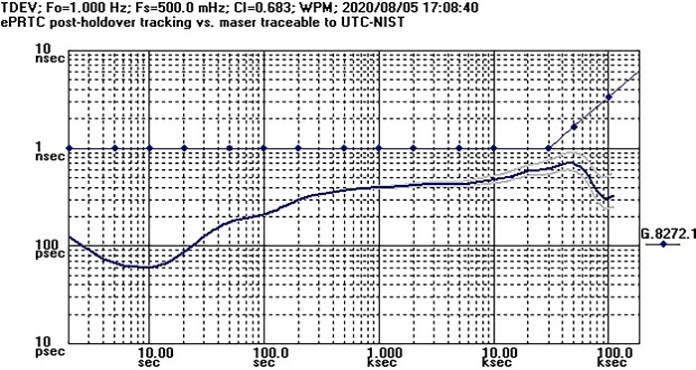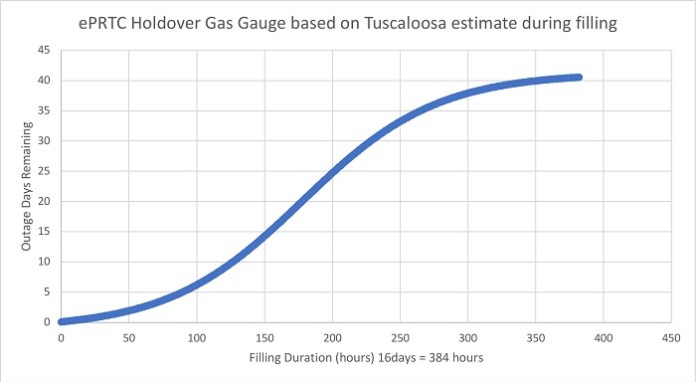Mobile operators require high-accuracy time and phase protection for their 5G networks, yet this is difficult to achieve when there is dependency on the global navigation satellite system (GNSS), which is vulnerable to disruption either from jamming, spoofing, or natural phenomena that can cause it to be unavailable for extended periods of time. The enhanced primary reference time clock (ePRTC) offers the mobile network operator a peace-of-mind solution: holdover that provides the necessary accuracy, reliability, and performance to resolve the problem.
Successful deployment of ePRTC requires a solid understanding of the key elements required to build a robust and resilient architecture for precise time, including the most appropriate clock and other related systems for the network operator’s needs.
Keeping 5G functioning
Imagine a mobile network that is very fast, enables videos to be downloaded quickly, and allows a dense 5G service to keep customers happy in many locations. Suddenly, everything is interrupted. Mobile service is down, and customers blame the mobile operator, damaging the operator’s reputation and leading to user churn. This could easily happen during a GNSS outage.
Mobile operators and teams responsible for national critical infrastructure have been contemplating various ways to either provide GNSS backup or rely less on the technology overall. Even as recently as 3G or 4G mobile networks, the prevailing radio technology was predominantly a frequency-based synchronization strategy. This is very well understood in the industry, widely deployed, and very effective.
With the advent of 5G, very stringent time and phase accuracy is necessary to maximize the use of precious spectrum where mobile operators have been making investments. Avoiding data collision and frequency interference is critical while also minimizing guard-band size to enhance and more efficiently use their spectrum. Precise timing makes this possible.
This level of precision requires a source of time, which is primarily provided via GNSS. With 5G’s network densification, however, this is not an option anymore. A loss of a GNSS receiver in a radio or base station requires the radio or base station to be taken out of service quickly to avoid interference issues due to the lack of high-quality holdover oscillators in the radio or base station. This technical consideration has caused timing of base stations to be less reliant on GPS and migrate to Precise Time Protocol (PTP) architectures. Mobile operators need to minimize the locations where GPS is used while retaining a very resilient architecture for precise time to ensure a continuity of customer service during GNSS disruptions.
The ePRTC standard is ideal for this challenge. It is one of several versions of a primary reference time clock (PRTC) that ITU Telecommunication Standardization Sector (ITU-T) has defined for time accuracy.
PRTC Class A can meet requirements for 100-ns accuracy relative to Coordinated Universal Time (UTC). PRTC Class B is more precise, at 40-ns accuracy. The enhanced PRTC has the highest accuracy, at 30 ns, as defined by ITU-T G.8272.1.
The ePRTC is uniquely designed to be the most resilient, with the ability to hold over for 14 days or more using the cesium clock as a reference while maintaining a maximum deviation of only 100 ns to UTC for the entire extended outage period. This is a key benefit of deploying ePRTC for a 5G mobile operator. If GPS is down, service delivery remains seamless throughout the entire network. This ensures the required time to repair the GPS disruption or survive extended periods of GPS unavailability.
Recommended
Time synchronization devices address 5G deployment issues
Importance of clocks and accessories
The ePRTC does not work in isolation. The core principle of a quality ePRTC is that it generates time by producing its own independent autonomous timescale. The timescale provides time, phase, and frequency that are aligned and calibrated to the GNSS signal over time. Using patented measurement algorithms, a quality ePRTC engine evaluates and measures its own autonomous timescale offset relative to GNSS.
The ePRTC system’s approach is to make the timescale the autonomous master source of time, while cesium clocks and GNSS help maintain the accuracy of the ePRTC timescale.
For this reason, the ePRTC ideally should be connected to both GPS and atomic clocks (cesium, typically, to maximize resilience, with two cesium clocks being advisable). The ePRTC does not simply lock to one atomic clock but actively and seamlessly locks to two clocks in a properly weighted timescale ensemble. For example, if one atomic clock degrades in performance, the ePRTC will gracefully de-weight it from influencing the outgoing time and frequency services.
What this highlights is the need for a quality ePRTC to have the proper intelligence for ensembling and autonomous timescale functions, while also being adept at “coupling” with quality atomic clocks. This is especially true for the holdover capability. The highest quality cesium clock will lead to the best holdover performance of the ePRTC system itself.
Setup and commissioning requirements
The success in constructing an optimized timescale system encompasses the cesium clocks and the ePRTC system and requires extreme care for setup and commissioning. The ITU standard specifies commissioning verifications that need to take place, including:
- ePRTC is fully locked to the incoming reference time signal and is not operating in warm-up.
- There are no failures or facility errors in the reference path, including but not limited to antenna failures.
- Environmental conditions are within the operating limits specified for the equipment.
- The equipment is properly commissioned and calibrated for fixed offsets such as antenna cable length, cable amplifiers, receiver delays, and the reference time signal (e.g., the GNSS signal is operating within limits, as determined by the relevant operating authorities).
- If the reference time signal is operated over a radio system such as GNSS, multi-path reflections and interference from other local transmissions, such as jamming, must be minimized to an acceptable level.
- There are no extreme propagation anomalies, such as severe thunderstorms or solar flares.
- Time reference is GNSS and the frequency reference is 1 pps/10 MHz from the atomic clocks. The common mistake is to set GNSS highest priority for both time and frequency, which puts the atomic clocks in a classic backup role and negates the operational advantages of ePRTC.
After considering these commissioning requirements, the next step in selecting an ePRTC solution is system validation and testing.
Validation and testing
There are three main phases of test and validation:
- 21-day “learning” period
- 14-day “holdover” period
- Seven-day “recovery” period
The 21-day learning period helps determine with ultra-high precision the UTC calibration correction parameters for the ePRTC timescale and the frequency offset estimate of the local cesium. The GNSS subsystem reports the continuous stream of time error measurements of the local timescale with respect to UTC so the local timescale rate can slowly be adjusted. This first three-week period helps to verify that the ePRTC indeed meets the time-accuracy specifications by ITU-T.

Fig. 1: After 21 days — shows compliance to the ITU-T G.8272.1 time accuracy standard (Image: Microchip)
During the 14-day holdover period, the GNSS signal is disconnected and the ePRTC must verify that it can hold 100 ns for 14 days in holdover. The better the cesium clock, the more performant this test will be.
As shown in Fig. 2, the tested ePRTC maintained time error performance limits within the 100-ns standard and maintained 25-ns clock class for almost the entire duration of the outage. The use of a high-performance cesium atomic clock delivered 4× better holdover performance than required by the standard.

Fig. 2: In tests of the ePRTC for Microchip’s TimeProvider 4100, time error is well within the 100-ns requirement (42 ns) after the 14-day outage (+1-day recovery). It returned to zero when GNSS reconnected. (Image: Microchip)
The recovery period is to verify that when reconnecting GNSS to the ePRTC unit, everything returns to normal. The goal is to verify successful re-convergence and re-establishment of normal 100% timescale protection operation, as shown in Fig. 3.

Fig. 3: Time deviation (TDEV) post-holdover period versus Maser UTC-NIST reference compared with the G.8272.1 standard shows results seven days post-holdover (Image: Microchip)
Importance of holdover “gas gauge”
The “gas gauge” is particularly useful, as it gives the mobile operator adequate visibility into how long the ePRTC holdover function will be able to keep 100-ns accuracy to UTC. The standard requires 14 days.

Fig. 4: Holdover gas gauge (just before the GNSS antenna was pulled) estimate is 40 days (much better than the required 14 days). (Image: Microchip)
The ePRTC standard meets 5G’s need for guaranteed delivery of consistent, highly precise phase and time. The ease with which it delivers this capability depends on proper deployment as part of a complete solution, including the correct clock and related systems that have been adequately validated, tested, and commissioned.
About the author
Eric Colard, head of emerging products, frequency & time systems, leads product line management for Microchip’s TimeProvider 4100 and Integrated GNSS Master solutions for the telecom, utility, and other industries. Eric’s leadership includes product definition, customer interaction, outbound promotions, and business development. He has held successive technical and leadership roles at technology companies in the U.S. and Europe. He began his career as an engineer in the networking arena on X.25, frame relay, and other protocols at companies including Alcatel and Cap Sesa Telecom. He later held successive product management and business development leadership roles in networking, security, and other areas at Novell, Tumbleweed, FaceTime, and Vernier Networks. As the industry rapidly progressed, Eric increasingly became involved in wireless data compression and TCP/IP optimization. In 2007, he joined Symmetricom and architected and built the SyncWorld ecosystem with partners Alcatel-Lucent, Ericsson, Nokia Siemens, and Cisco. Through acquisition, Symmetricom became part of Microsemi, which today is part of Microchip.
He holds Bachelor of Science and Master of Science degrees in computer science, both from École Nationale Supérieure des Télécommunications (now Télécom ParisTech) in Paris, France. He is a member of the Metro Ethernet Forum (MEF), Open Compute, Telecom Infra Project, and Small Cell Forum. He has received an award for his industry contributions from the Small Cell Forum.
Advertisement
Learn more about Microchip Technology





